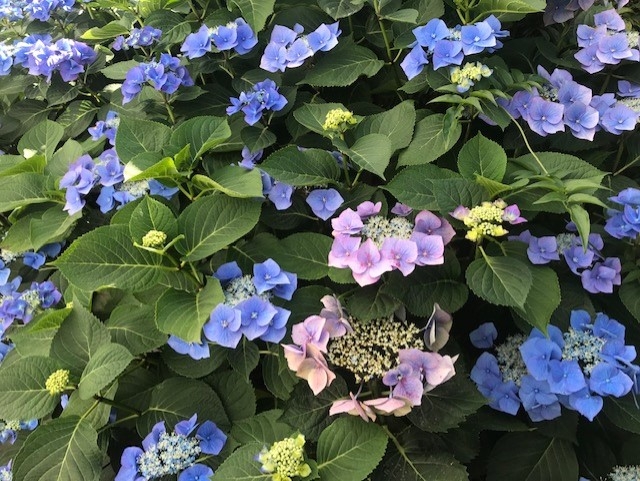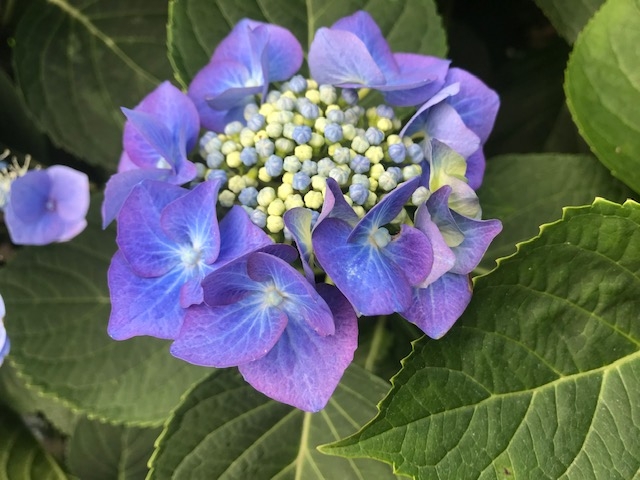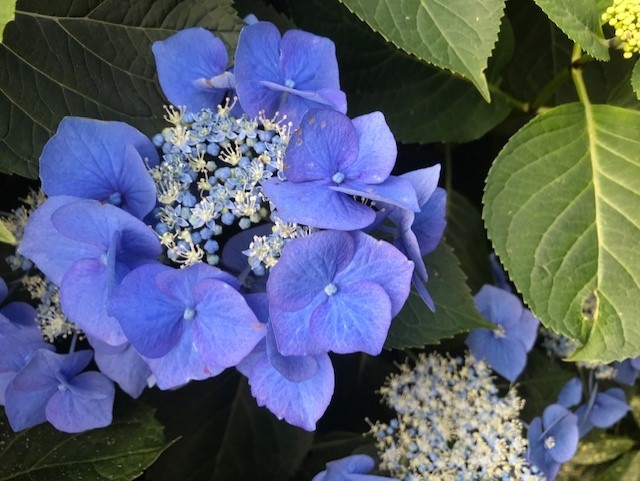
An extra bonus are the bumble bees that frequent my lacecap. The inner part of the flower cluster of the lacecap contains fertile flowers that have nectar and pollen which attracts the bees. Lacecap Hydrangeas are a great choice for pollinator gardens. Not all Hydrangeas attract bees, as most Hydrangeas have flowers which are sterile and do not have nectar. The “petals” on the Hydrangeas are botanically considered sepals. Hydrangeas do not produce large amounts of pollen which makes them a great floral arrangement choice for people with pollen allergies.
The Hydrangea is one of the most beloved shrubs, and these beauties thrive here on the North Coast. I have loved Hydrangeas ever since I was old enough to have an appreciation for beautiful plants. My landscapes always had hydrangeas, even if they had to be given extra attention. When I lived in the Central Valley, they could be quite the divas, wilting and drooping their voluptuous blossoms with temps rising over 90 degrees F. I belong to a couple of social media Hydrangea groups, and I am amazed to see what lengths admirers of the Hydrangea will take, hoping that their plant will survive and bless them with their beautiful blooms. The Sunset Zones recommends zones 3b-9, 14-24 and H1 for the macrophylla.
Genus: Hydrangea (high DRAN jee ah)
Species: macrophylla (mac roh FI uh)
Family: Hydrangeaceae
My shrub is Hydrangea macrophylla 'Mariesii Perfecta' BLUE WAVE
The genus name Hydrangea comes from hydor meaning "water" and aggeion meaning "vessel", in reference to the cup-like capsular fruit. Specific epithet comes from the Greek words makros meaning large and phyllon meaning leaf in reference to plant leaves.
'Mariesii Perfecta' is a lacecap cultivar that features rich blue flowers. This cultivar was first introduced into commerce in 1904 by Victor Lemoine. It is synonymous with and has been marketed under the trade name of BLUE WAVE.

The lacecap will tolerate sun in moderate climate provided that the soil is kept moist, however it is the happiest with afternoon shade. The lacecap tolerates almost all well-draining soil types from clay to sandy soils, and it also has some tolerance for salt. For the more inland areas of Humboldt, It is best to plant in the spring after frosts and before the hotter summer months. Established Hydrangeas can be transplanted in the spring or fall, but I personally would recommend the fall. Beware that deer are attracted to this shrub.
Fertilize with balanced fertilizer in the spring and early fall. However, it is not always necessary. One sign of needing fertilizer is when you see yellowing leaves in the center of the plant right before it begins to bloom.
Hydrangeas like a lot of water, but do not like their roots sitting in water. Overwatering signs are browning of the leave margins and dropping of their leaves. These divas also let you know that they are thirsty when they begin to droop.
There are pests and diseases that can cause issues with this shrub. However, the better the cultural care you provide, the less problems will arise. They may be susceptible to bud blight, bacterial wilt, leaf spot and mildew. Aphids may be attracted to the fresh green foliage. I will find the occasional snails, which I will hand pick, bag and toss in the garbage. The UCANR Integrative Pest Management has excellent information for pests and diseases associated with Hydrangea, IPM Link.
This plant needs little pruning. If needed, prune immediately after flowering by cutting back flowering stems to a pair of healthy buds. Prune out weak or winter-damaged stems in late winter/early spring. To help the soil to retain moisture, mulch plants year-round with 3" of shredded bark, peat or compost. Pull mulch away from the trunk of the shrub to deter possible problems.
Propagation of the hydrangea can be accomplished by several methods: layering, leaf cutting, and stem cutting. Propagating Information
Enjoy Them Inside
I enjoy bringing my hydrangeas inside as much as I enjoy them in my garden. To harvest the flowers, I recommend the following: water the shrub the day before cutting; harvest in the morning's cool temperature; the best time to harvest is when 80-90% of the sepals (petals) are open; use a clean container of water and clean disinfected clippers; immediately place stems into water.
To help the blossom last in a vase or arrangement: remove the lower leaves (leaves below the water line will create bacteria); hold the stem under water to recut the stem at an angle; use a floral preservative; do not place arrangement in a warm or sunny location. Home Made Floral Preservative Recipe: For each quart of water add the following, 1 tablespoon sugar + ¼ teaspoon bleach + 1 tablespoon lemon juice.
I also enjoy drying hydrangeas, and I recommend harvesting from August through October (just as they begin to lose their fresh color); either hang upside down or stand in a vase (without water) and place in a dry location.
References:
North Carolina Extension Gardener Plant Toolbox https://plants.ces.ncsu.edu/plants/hydrangea-macrophylla/
Oregon State University https://landscapeplants.oregonstate.edu/plants/hydrangea-macrophylla
Oregon State University – General care for hydrangeas https://extension.oregonstate.edu/gardening/flowers-shrubs-trees/general-care-hydrangeas
Missouri Botanical Garden https://www.missouribotanicalgarden.org/PlantFinder/PlantFinderDetails.aspx?taxonid=249023&isprofile=0&#:~:text=Noteworthy%20Characteristics,harsh%20winters%20or%20pruned%20smaller
The New Sunset Western Garden Book, Third printing 2017 pages 367-369
Photographs - Courtesy of Sherida Phibbs